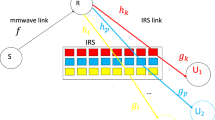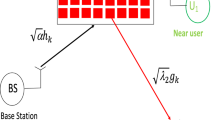Abstract
In this paper, we propose to extend the coverage of millimeter-wave (mmwave) communications using Reconfigurable Intelligent Surfaces (RIS). The first hop between the source and the relay node uses millimeter-wave communications. The received signal at relay node R is affected by P interferers. The relay node decodes the transmitted packet by the source. Then, the relay node transmits the decoded packet to the destination. A RIS is placed between relay R and destination D. RIS is implemented as a reflector to reflect signals from R to D. All reflected signals have the same phase so that the throughput is significantly enhanced. RIS is also implemented as a transmitter and illuminated with the antenna of relay node R. We show that RIS allows up 19, 25, 31, 37 dB gain with respect to conventional millimeter-wave communication without RIS for a number of reflectors \(N=16,32,64,128\). We also propose RIS for mmwave communications using Non Orthogonal Multiple Access (NOMA). A set of RIS reflectors is dedicated to each NOMA user. The proposed NOMA system using RIS offers 10, 13, 16, 20, 24, 27 and 30 dB gain with respect to conventional NOMA using millimeter-wave communications without RIS for a number of reflector per user \(N=N_1=N_2=8,16,32,64,128,256,512\).
















Similar content being viewed by others
Data availibility
Data and material are not available.
References
Zöchmann, E., Groll, H., & Pratschner, S. (2019). A small-scale fading model for overtaking vehicles in a millimeter wave communication link. In 2019 IEEE 20th international workshop on signal processing advances in wireless communications (SPAWC).
Jihao, L., Zhenfeng, Y., Yibing, L., Xiaohang, S., Ji, L., & Wei, Z. (2019). Research on millimeter wave phased array antenna for 5G communication. In 2019 IEEE 2nd international conference on electronic information and communication technology (ICEICT).
Tsai, C.-H., Pepe, F., Mangraviti, G., Zong, Z., Craninckx, J., & Wambacq, P. (2019). A 22.5–27.7-GHz fast-lock bang–bang digital PLL in 28-nm CMOS for millimeter-wave communication with 220-fs RMS jitter. IEEE Solid-State Circuits Letters, 2(9), 232–239.
Pan, P., Zi, Z., Cai, J., & Feng, J. (2019). Millimeter wave vacuum electronic amplifiers for high data rate communication. In: 2019 44th international conference on infrared, millimeter, and terahertz waves (IRMMW-THz).
Kaur, J., & Lal Singh, M. (2019). User assisted cooperative relaying in beamspace massive MIMO NOMA based systems for millimeter wave communications. China Communications, 16(6), 103–11.
Fukatsu, R., & Sakaguchi, K. (2019 ). Millimeter-wave V2V communications with cooperative perception for automated driving. In IEEE 89th vehicular technology conference (VTC2019-Spring).
Zhang, J., Huang, Y., Xiao, M., Wang, J., & Yang, L. (2018). Energy-efficient cooperative hybrid precoding for millimeter-wave communication networks. In 2018 IEEE global communications conference (GLOBECOM).
Zhang, J., Huang, Y., Zhang, C., He, S., Xiao, M., & Yang, L. (2017). Cooperative multi-subarray beam training in millimeter wave communication systems. In GLOBECOM 2017—2017 IEEE global communications conference.
Kaur, J., & Lal Singh, M. (2019). User assisted cooperative relaying in beamspace massive MIMO NOMA based systems for millimeter wave communications. China Communications, 16(6), 103–113.
Zhu, R., Wang, Y.E., Xu, Q., Liu, Y., & Li, Y.D. (2018). Millimeter-wave to microwave MIMO relays (M4R) for 5G building penetration communications. In IEEE radio and wireless symposium (RWS), 2018.
Basar, E., Di Renzo, M., De Rosny, J., Debbah, M., Alouini, M.-S., & Zhang, R. (2019). Wireless communications through reconfigurable intelligent surfaces. IEEE Access, 7, 116753–116773.
Zhang, H., Di, B., Song, L., & Han, Z. (2020). Reconfigurable intelligent surfaces assisted communications with limited phase shifts: How many phase shifts are enough? IEEE Transactions on Vehicular Technology, 69(4), 4498–4502.
Di Renzo, M. (2019). 6G wireless: Wireless networks empowered by reconfigurable intelligent surfaces. In 2019 25th Asia-Pacific conference on communications (APCC).
Basar, E. (2020). Reconfigurable intelligent surface-based index modulation: A new beyond MIMO paradigm for 6G. IEEE Transactions on Communications, 68, 3187–3196.
Wu, Q., & Zhang, R. (2020). Towards smart and reconfigurable environment: Intelligent reflecting surface aided wireless network. IEEE Communications Magazine, 58(1), 106–112.
Huang, C., Zappone, A., Alexandropoulos, G. C., Debbah, M., & Yuen, C. (2019). Reconfigurable intelligent surfaces for energy efficiency in wireless communication. IEEE Transactions on Wireless Communications, 18(8), 4157–4170.
Alexandropoulos, G. C., & Vlachos, E. (2020). A hardware architecture for reconfigurable intelligent surfaces with minimal active elements for explicit channel estimation. In ICASSP 2020—2020 IEEE international conference on acoustics, speech and signal processing (ICASSP).
Guo, H., Liang, Y.-C., Chen, J., & Larsson, E. G. (2020). Weighted sum-rate maximization for reconfigurable intelligent surface aided wireless networks. IEEE Transactions on Wireless Communications, 19, 3064–3076.
Thirumavalavan, V. C, & Jayaraman, T. S. (2020). BER analysis of reconfigurable intelligent surface assisted downlink power domain NOMA system. In 2020 international conference on communication systems and networks (COMSNETS).
Yang, L., Guo, W., & Ansari, I. S. (2020). Mixed dual-hop FSO-RF communication systems through reconfigurable intelligent surface. IEEE Communications Letters, 24, 1558–1562.
Di, B., Zhang, H., Li, L., Song, L., Li, Y., & Han, Z. (2020). Practical hybrid beamforming with finite-resolution phase shifters for reconfigurable intelligent surface based multi-user communications. IEEE Transactions on Vehicular Technology, 69(4), 4565–4570.
Nadeem, Q.-U.-A., Kammoun, A., Chaaban, A., Debbah, M., & Alouini, M.-S. (2020). Asymptotic max-min SINR analysis of reconfigurable intelligent surface assisted MISO systems. IEEE Transactions on Wireless Communications, 19, 7748–7764.
Zhao, W., Wang, G., Atapattu, S., Tsiftsis, T. A., & Tellambura, C. (2020). Is backscatter link stronger than direct link in reconfigurable intelligent surface-assisted system? IEEE Communications Letters, 24, 1342–1346.
Dai, L., Wang, B., Wang, M., Yang, X., Tan, J., Bi, S., et al. (2020). Reconfigurable intelligent surface-based wireless communications: Antenna design, prototyping, and experimental results. IEEE Access, 8, 45913–45923.
Li, J., Li, X., Ye, N., & Wang, A. (2019). Performance evaluation of MIMO-NOMA in millimeter wave communication for broadcast services. 2019 IEEE international symposium on broadband multimedia systems and broadcasting (BMSB) (pp. 5–7). Jeju-si: South Korea.
Kaur, J., & Singh, M. L. (2019). User assisted cooperative relaying in beamspace massive MIMO NOMA based systems for millimeter wave communications. China Communications, 16(6), 103–113.
Guo, L., Cong, S., & Su, C. (2020). On coverage probability of uplink NOMA in millimeter wave cellular networks. In 2020 9th Asia-Pacific conference on antennas and propagation (APCAP), 4–7 Aug.
Azzahra, M. A. (2019). NOMA signal transmission over millimeter-wave frequency for backbone network in HAPS with MIMO antenna. In 2019 IEEE 13th international conference on telecommunication systems, services, and applications (TSSA).
Luo, Z., Zhao, L., Tonghui, L., Liu, H., & Zhang, R. (2021). Robust hybrid precoding/combining designs for full-duplex millimeter wave relay systems. IEEE Transactions on Vehicular Technology, 70, 9577–9582.
Ma, K., He, D., Sun, H., Wang, Z., & Chen, S. (2021). Deep learning assisted calibrated beam training for millimeter-wave communication systems. IEEE Transactions on Communications.
Wen, L., Zhiqiang, Y., Zhu, L., & Zhou, J. (2021). High-gain dual-band resonant cavity antenna for 5G millimeter wave communications. IEEE Antennas and Wireless Propagation Letters, 20(10), 1878–1882.
Ghasemi, A., & Sousa, E. S. (2007). Fundamental limits of spectrum-sharing in fading environments. IEEE Transactions on Wireless Communication, 6(2), 649–658.
Gradshteyn, I. S., & Ryzhik, I. M. (1994). Table of integrals, series and products (5th ed.). San Diego, CA: Academic.
Proakis, J. (2007). Digital communications (5th ed.). New York: Mac Graw-Hill.
Xi, Y., Burr, A., Wei, J. B., & Grace, D. (2011). A general upper bound to evaluate packet error rate over quasi-static fading channels. IEEE Transactions on Wireless Communications, 10(5), 1373–1377.
Ziskind, I., & Wax, M. (1987). Maximum likelihood estimation via the alternating projection maximization algorithm. IEEE International Conference on Acoustics, Speech, and Signal Processing, Dallas, Texas, 12, 2280–2283.
Tan, P., & Nicolas, C. (2021). Millimeter-wave antenna selection switch using advanced CMOS technologies. In 2021 international symposium on electrical and electronics engineering (ISEE) (pp. 1–4).
Funding
This publication was supported by Saudi Electronic University.
Author information
Authors and Affiliations
Contributions
The paper is the contribution of Prof. Raed Alhamad and Prof. Hatem Boujemaa.
Corresponding author
Ethics declarations
Conflict of interest
The authors state that there is no conflict of interest for this paper.
Appendix A
Appendix A
Let \(X=E_S|f|^2\) and \(I=\sum _{q=1}^PI_q\). The SNR at R is expressed as \(\Gamma _{SR,mmwave}=\frac{X}{I}\). X and I are two independent Gamma r.v. with joint PDF [34]
Let \(\Gamma _{SR,mmwave}=U=\frac{X}{I}\) and \(V=X+I\), the determinant of Jacobian matrix is
We can write \(I=\frac{V}{1+U}\) and \(X=\frac{UV}{1+U}\). We deduce the joint PDF of (U, V)
The PDF of \(U=\Gamma _{SR,mmwave}\) is computed as
We have [33]
Rights and permissions
About this article
Cite this article
Alhamad, R., Boujemaa, H. Throughput enhancement for millimeter wave communications using reconfigurable intelligent surfaces. Telecommun Syst 79, 369–385 (2022). https://doi.org/10.1007/s11235-021-00865-z
Accepted:
Published:
Issue Date:
DOI: https://doi.org/10.1007/s11235-021-00865-z




